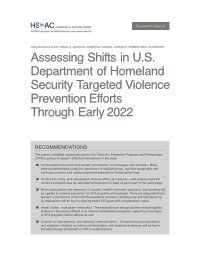By Caitlin McCulloch, Brian A. Jackson, Sameer M. Siddiqi, Jordan R. Reimer, Emily Allendorf
The U.S. Department of Homeland Security (DHS) has changed and expanded its efforts in violence prevention in the past five years. DHS asked the Homeland Security Operational Analysis Center (HSOAC) to examine the change in efforts by the Center for Prevention Programs and Partnerships (CP3) and its predecessor organizations in preventing terrorism and other violence and explore options for CP3 moving forward.
In the United States, the full potential value of countering violent extremism (CVE) has never been realized because of key disconnects between the intent of CVE programs and the realities of their implementation. Although it might not have been the intent, efforts singled out and stigmatized American Muslim communities. The disconnect between stated intention and reality stimulated potent opposition to CVE as a concept. In response, the federal government decided to make significant changes in its approaches in this policy area. In late 2021, DHS asked HSOAC to examine and characterize the changes that had been made, providing an outside viewpoint on the extent of change and how those changes had responded to the concerns about CVE efforts. This report documents the researchers' approach, findings, and recommendations.
Key Findings
There has been enormous growth in CP3, and it is currently working on developing and standardizing the institutions and processes that are required to support a larger organization. These efforts include extensive standardization efforts in training and evaluation of CP3's work. Coronavirus disease 2019 (COVID-19) posed some problems, including making it difficult to create a cohesive whole with new personnel, but also presented some new opportunities, such as an increased ability to reach a diversity of stakeholders digitally.
CP3 and the government more broadly have made major shifts in the rhetorical framing of their work, toward a public health–informed approach, a framing that aligns more closely with the intent of their programs. Although there is still discussion of the implications of a public health–informed approach, this shift was reflected in both interviews and official documentation.
In line with this rhetorical shift is the expansion in the diversity of stakeholders, both in engagement and in grantees, including evidence of a shift away from criminal justice and security partners, although they remain important collaborators.
External stakeholders remain skeptical, but there are some signs of increasing trust in relevant actors outside government.
Recommendations
Continue efforts to build and sustain consistency in messages and activities. Many external stakeholders noted the importance of rebuilding trust and that sustainable and continuous actions and relationships were essential for fostering that trust.
Continue to codify and standardize internal office procedures—with rapid growth comes a renewed need for new internal institutions to keep all personnel on the same page.
More clearly define the elements of a public health–informed approach and how they will be applied to violence prevention for CP3 programs and outreach. There are many definitions present in practitioner circles and the academic literature; choosing one and fully exploring the implications of the definition will be key for aligning stated CP3 goals with programmatic action.
Invest further in program evaluation. The research team recognizes that it is difficult to evaluate effectiveness in this area, but, without standardized evaluation, supporting the impact of CP3 programs will be difficult.
Commit to transparency and external communication. Transparency in actions taken and evidence collected, as well as communication with skeptical audiences, will be key in showing change and growth in CP3 and its activities to external actors and in further building trust with external audiences.



